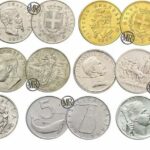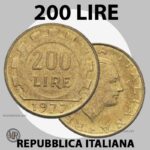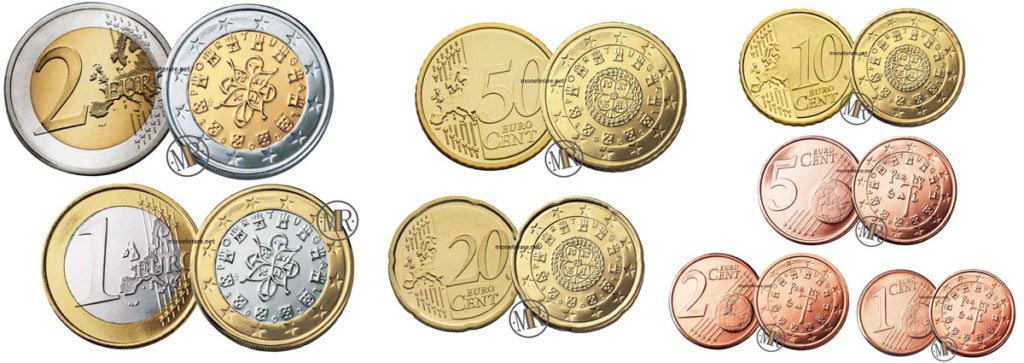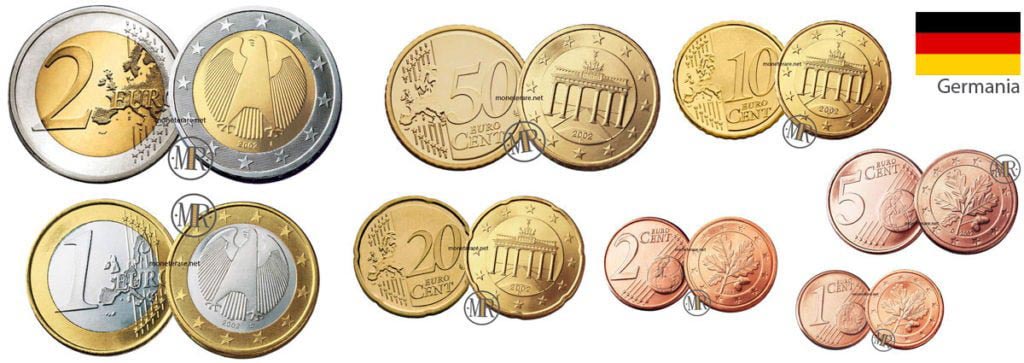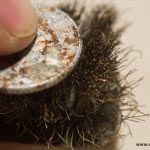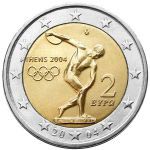If we talk about the Euro coin collection and therefore all the euro coins of the various European countries, we can not fail to mention the beautiful collection of Spanish Euro Coins which is composed of three coins of small denomination in copper, three Nordic Gold and two bimetallic coins of 1 and 2 euro.
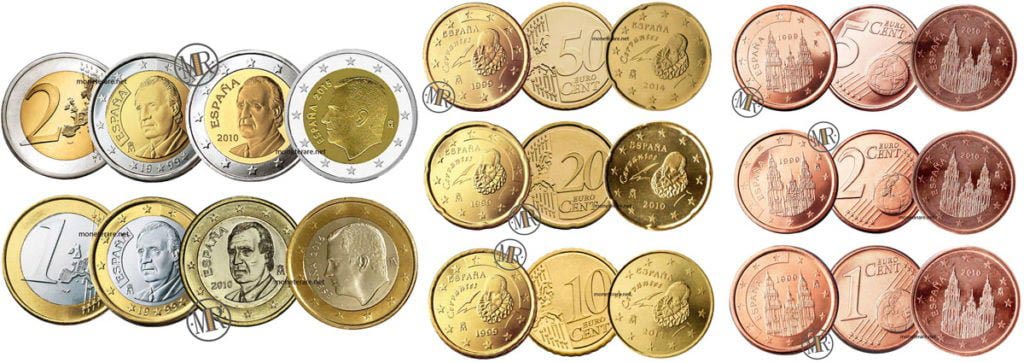
Introduction from the Peseta to the Spanish Euro Coins
We begin this article dedicated to Spanish Euro coins by introducing what is the history of Spanish general numismatics.
Come tutti i Paesi dell’Unione Europea anche la Spagna, prima di passare alla Moneta Unica, aveva un’altra valuta.
Quella spagnola era la Peseta.
Like all EU countries, Spain also had another currency before moving to the Single Currency. The Spanish currency was the Peseta.
Specifically, this was introduced in the 19th century, when Spain was preparing to join the Latin Monetary Union. Precisely the year of admission of Spain is 1868 or the same year in which the first Peseta was coined.
The latter replaced the Escudo with an exchange rate corresponding to 2.5 Pesetas for 1 escudo.
The peseta was originally divided into 100 Céntimos or, in a much more informal way, 4 Reales.
Precisely the peseta was equal to 4.5 grams of silver or 0.290322 grams of gold and was the official currency in both Spain and Andorra. In the latter, however, it was used together with the French franc.
Due to political turbulence, the Latin Monetary Union was first revoked and then officially dissolved in 1927. However, the peseta remained the official currency in Spain until 1999.
The introduction of the Euro
On January 1, 1999, the Euro came into force and replaced the peseta with an exchange rate set at 1 euro = 166.386 pesetas. As for all the other European countries, the peseta continued to be the “physical” currency until 2002, while for the “non-physical” payments the Euro was used.
From 1 to 28 January 2002 a phase of double circulation began to allow the population to change the Pesetas into Euro. From March 1st 2002 the peseta lost value both in Spain and in Andorra even if it is still possible to change the Pesetas in Euro until December 31st 2020.
After this brief but necessary introduction we can start our journey to discover the Spanish Euro coins. In the course of this analysis we will take into consideration the subjects depicted, the technical characteristics of the coins and interesting aspects.
Let’s start.
1 Cent Spanish Euro Coins
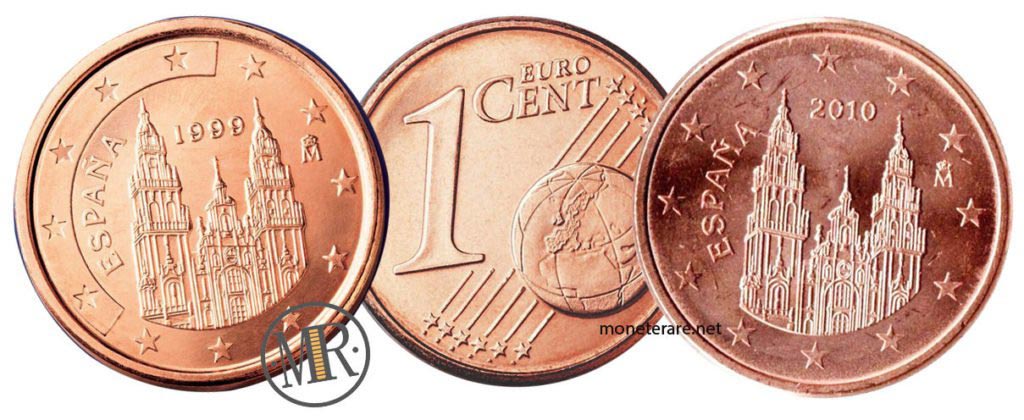
The first coin we will be analysing is, of course, the 1 cent Spanish Euro Coins . Specifically, the author of this coin is Garcilano Rollan.
There have been four editions of this same coin that date back precisely to the years 1999 to 2009 for the first two series, under King Juan Carlos I. Instead for the third and fourth series in the years 2010 to 2014 under King Juan Carlos I first and from 2015 onwards under King Felipe VI.
On the obverse, the coin depicts the Cathedral of Santiago de Compostela. Between the two towers at the top there is the thousandth of minting while on the right the “M” crowned symbol of the Mint of Madrid.
On the left there is the inscription ESPAÑA. The whole is surrounded by 12 five-pointed stars that symbolize the states of the European Union. Specifically with regard to the versions from 1999 to 2009, the stars number 8,9,10,11 and 12 are enclosed in a section of circular crown while in more recent versions this disappears.
On the Reverse side, the coin has the same face as all other European 1-cent coins.
Let’s see now the technical characteristics.
Technical specifications of the Spanish Euro cent
- Materials: The material used for this coin is steel plated with copper (steel 94.35% – copper 5.65%).
- Thickness: The thickness is equal to 1.67 mm
- Weight: The weight is 2.3 g
- Diameter: The diameter is 16.25 mm
- Side dish: The contour is completely smooth
- Engraver: Garcilano Rollan
1 Spanish Euro Cents Value and circulation
Let’s go and see the prices of the Spanish 1-cent coins and their value.
1 Euro Cent Spain | First series
1 Euro Cent Spain | Second series
1 Euro Cent Spain | Third series
1 Euro Cent Spain | Fourth series
2 Cent Spanish Euro Coins
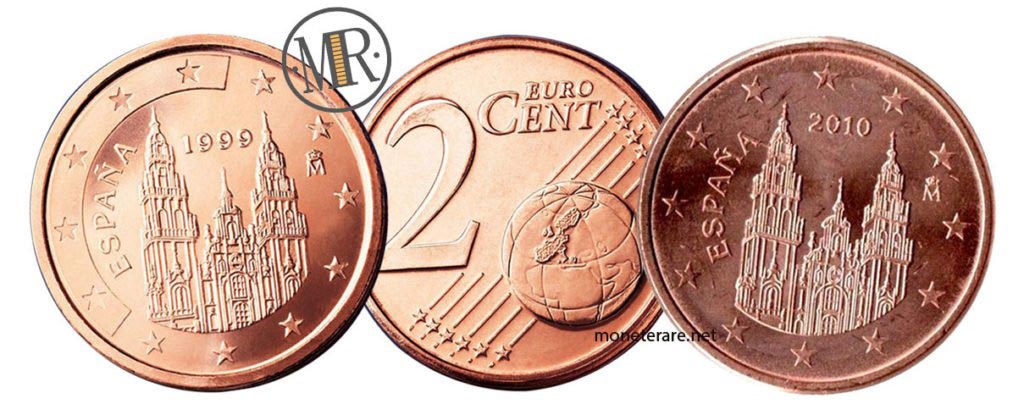
Now let’s move on to the 2 cent Spanish Euro Coins also produced by Garcilano Rollan.
Again, we are talking about four editions of the same coin, which date back to the period between 1999 and 2009 for the first and second editions, and from 2010 to 2015 for the third and fourth editions.
On the obverse, the coin depicts the Cathedral of Santiago de Compostela, perfectly placed in the centre. At the top between the two towers there is the thousandth of minting while on the left arranged in a semicircle the inscription ESPAÑA.
On the right the crowned “M” symbol of the Mint of Madrid. The whole is surrounded by 12 five-pointed stars, symbol of the European Union. It is important to underline that also in this case for the first two series (1999 – 2009) the stars are enclosed in a section of circular crown, while in the new editions this disappears.
On the Reverse side, the coin has the same face as the other European 2-cent coins.
Let’s now see together the technical specifications
Technical specifications of the Spanish 2 Euro cent
- Materials: Also for the 2 centesimi coin the material used is steel plated with copper. Steel is present for 94.35% and copper for 5.65%.
- Thickness: The thickness is always 1.67 mm.
- Weight: The slightly higher weight is 3.06 g
- Diameter: The diameter is equal to 18.75 mm
- Side dish: The contour is characterized by an incused horizontal thread
- Engraver: Garcilano Rollan
2 Spanish Euro Cents Value and circulation
Let’s go and see the prices of the 2 cents euro coins of Spain and their value.
2 Euro Cent Spain | First series
2 Euro Cent Spain | Second series
2 Euro Cent Spain | Third series
2 Euro Cent Spain | Fourth series
2 Cent Spanish Euro Coins
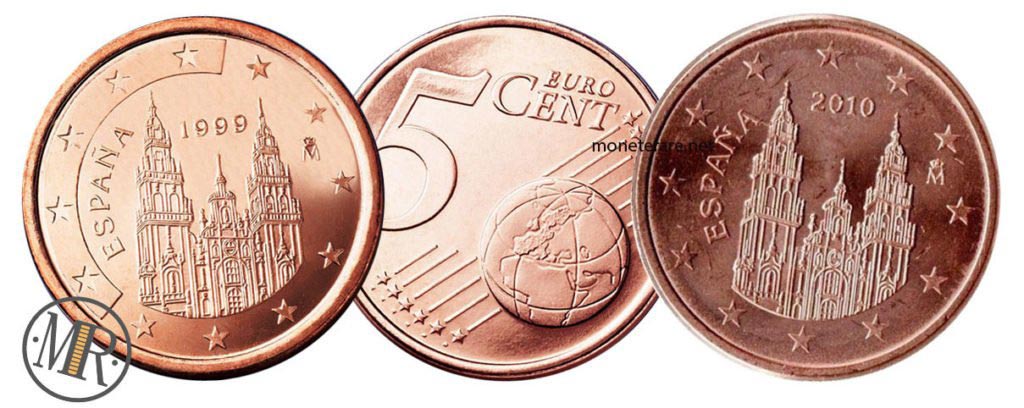
We now come to the 5 cent Spanish Euro Coins. Also in this case the author is Garcilano Rollan.
As for the 1 and 2 cents coins, also in this case there are four editions dating back to 1999/2009 the first two and 2010/2015 the third and fourth.
On the obverse, the coin shows a representation of the Cathedral of Santiago de Compostela, perfectly placed in the centre. On the right there is the crowned “M”, symbol of the Mint of Madrid, while on the left there is the inscription ESPAÑA in a semicircle.
At the top between the two towers there is the minting symbol. The whole is surrounded by the 12 five-pointed stars that symbolize the states of the European Union. In the first two editions (1999 – 2009) the stars number 8,9,10,11 and 12 are placed in a section of circular crown that disappears in the new editions.
On the reverse side, the coin has the same face as the other 5-cent coins with the representation of Europe.
Let’s see together now the technical specifications.
Technical specifications of the Spanish 5 Euro cent
- Materials: Also in this case the material used is steel (94.35%) plated with copper (5.65%).
- Thickness: The thickness is always 1.67 mm
- Weight: Weight still rises to 3.92 g
- Diameter: The diameter is 21.25 mm
- Side dish: The contour is completely smooth
- Engraver: Garcilano Rollan
5 Spanish Euro Cents Value and circulation
Let’s see now the quotations of the 5 cent euro coins of Spain and their value.
5 Euro Cent Spain | First series
5 Euro Cent Spain | Second series
5 Euro Cent Spain | Third series
5 Euro Cent Spain | Fourth series
10 Cent Spanish Euro Coins
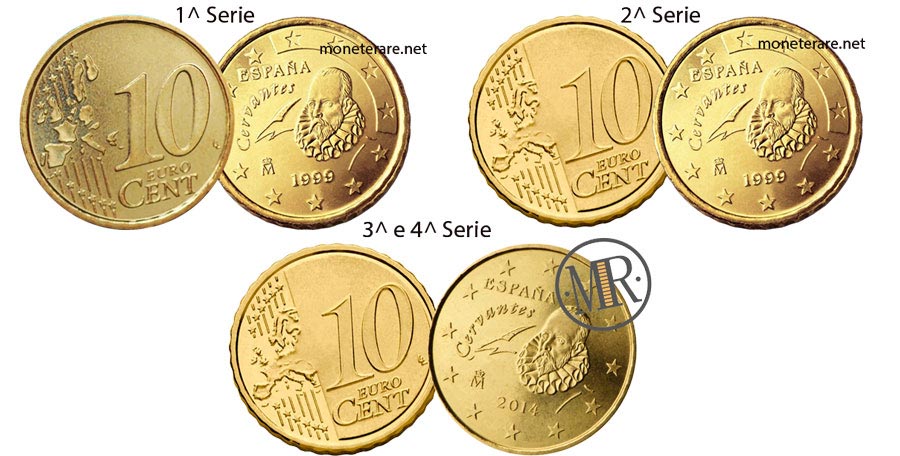
We now come to the 10 cent Euro Spain coin which changes from the previous ones. The author is no longer Rollan but Begoña Catellanos.
There are also four editions of the 10-cent coin:
- 1^ Series from 1999 to 2006
- 2^ Series from 2007 to 2009
- 3^ and 4^ Series from 2010
In the obverse the coin shows Miguel de Cervantes Saavedra, Spanish writer, poet and playwright who lived between the 6th and 7th centuries.
On the left of the bust there is the inscription “Cervantes” arranged in a semicircle and immediately above the inscription ESPAÑA.
Under the bust of the poet there are instead the thousandth of minting in the center and slightly to the left the “M” crowned symbol of the Mint of Madrid.
The whole is surrounded by 12 five-pointed stars. In the first two editions (1999 – 2019), the stars corresponding to 12, 1, 2 and 3 o’clock are inserted in a circular crown.
The box with the stars, on the other hand, disappears in the 2010 editions.
On the reverse side, the coin has the same face as the other 10-centime European coins.
Until 2006, the map of the European Union was depicted with the borders between countries, borders that disappear from 2007 onwards.
But let’s move on to the technical specifications.
Technical specifications of the Spanish 10 Euro cent
- Materials: The material used is Nordic Gold consisting of 89% copper, 5% zinc, 5% aluminium and 1% tin.
- Thickness: The thickness is slightly higher than the previous coins being equal to 1.93 mm
- Weight: Weight also increases by activating to 4.10 g
- Diameter: The diameter is 19.75 mm
- Side dish: The contour is grooved with thick knurling
- Engraver: Begoña Catellanos
10 Spanish Euro Cents Value and circulation
Let’s go and see the prices of the Spanish 10 cents coins and therefore their value for each year of minting.
10 Euro Cent Spain | First series
10 Euro Cent Spain | Second series
10 Euro Cent Spain | Third series
10 Euro Cent Spain | Fourth series
20 Cent Spanish Euro Coins
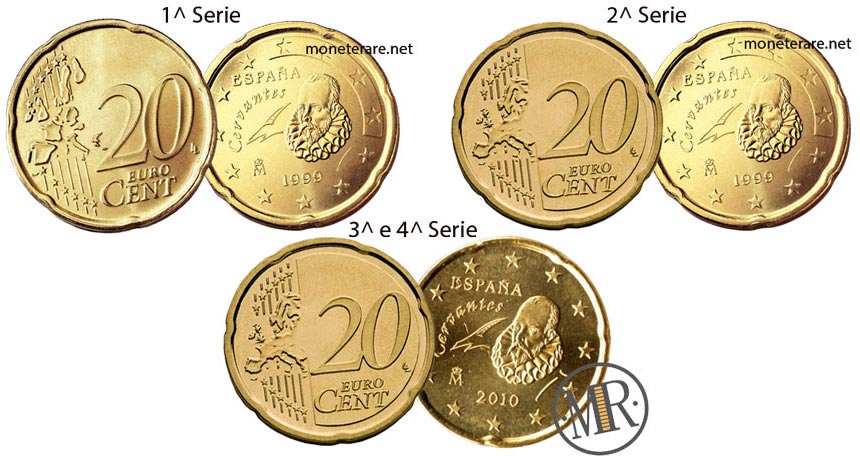
The design on the 20 cents Euro Spain coin was made by the same author as the previous 10 cents coin, Begoña Catellanos.
Also for this coin we speak of four editions and two different Kings.
- 1^ Serie from 1999 to 2006
- 2^ Serie from 2007 to 2009
- 3^ and 4^ Serie from 2010
In the obverse the coin shows the bust of Miguel de Cervantes Saavedra known Spanish writer, poet and playwright who lived between the sixth and seventh centuries.
On the left of the bust there is a goose down pen that draws the “Cervantes” writing.
Immediately above is the inscription ESPAÑA while below, just below the bust, are the thousandth of minting and the “M” crowned symbol of the Mint of Madrid. The whole is surrounded by 12 five-pointed stars representing the countries of the European Union.
In the first two editions, those dating from 1999 – 2009, the stars corresponding to 12, 1, 2 and 3 o’clock are enclosed in a raised semicircle, semicircle that disappears in the editions after 2010.
The coin has the same face on the reverse as the other 20-centime European coins. Until 2006 the countries of the Euro Zone are represented with borders between the various states, then the common side changes and the borders disappear.
Let’s see now the technical specifications.
Technical specifications of the Spanish 20 Euro cent
- Materials: Even for the 20-cent coin we speak of Nordic Gold consisting of 89% copper, 5% aluminum, 5% zinc and 1% tin
- Thickness: The thickness is greater than the previous coin coming to 2.14 mm
- Weight: Same for the weight which reaches 5.74 g
- Diameter: The diameter is 22.25 mm
- Side dish: The contour is characterized by a wide knurling
- Engraver: Begoña Catellanos
20 Spanish Euro Cents Value and circulation
Let’s go and see the prices of the 20 cents Spanish euro coins and therefore their value for each year of minting.
20 Euro Cent Spain | First series
20 Euro Cent Spain | Second series
20 Euro Cent Spain | Third series
20 Euro Cent Spain | Fourth series
20 Euro Cent Spain 1999 value
The 20 cent coins from Spain from 1999 are very common. In fact they have been minted in great number and do not have an interesting value or quotation.
50 Cent Spanish Euro Coins
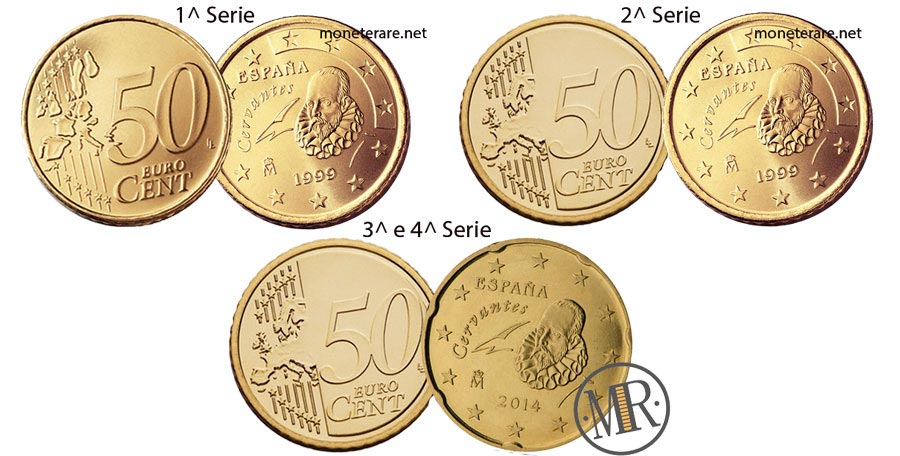
We have arrived at the 50 cents Spanish Euro Coins which, like the previous one, was made by Begoña Catellanos.
Again, we are talking about four different editions:
- 1^ Series from 1999 to 2006
- 2^ Serie from 2007 to 2009
- 3^ and 4^ Series from 2010
On the obverse, the coin shows a representation of the bust of Miguel de Cervantes Saavedra, Spanish poet, writer and playwright who lived between the 6th and 7th centuries.
Next to the bust of the poet, on the left, there is a goose feather and the inscription “Cervantes“.
Immediately above the inscription ESPAÑA while below the thousandth of minting and the crowned Mint symbol of Madrid.
The whole is surrounded by 12 five-pointed stars representing the countries of the European Union. It is interesting to note that while in the first two editions the stars corresponding to the hours 12, 1, 2 and 3 of the watch are placed in a section of circular crown, in subsequent editions this disappears.
On the reverse side, the coin has the same face as the other 50-centime European coins. Only for the 1st series the map of the European Countries is with the borders between the various states, in the other editions the map with the unified countries has been adopted.
Let’s see now the technical specifications
Technical specifications of the Spanish 50 Euro cent
- Materials: The material used is Nordic Gold consisting of 89% copper, 5% aluminium, 5% zinc and 1% tin.
- Thickness: The thickness is 2.38 mm.
- Weight: Weight is equal to 7.80 g
- Diameter: The diameter is 24.25 mm
- Side dish: The contour is grooved with thick knurling
- Engraver: Begoña Catellanos
50 Spanish Euro Cents Value and circulation
Andiamo a vedere le quotazioni delle monete da 50 centesimi di euro spagnole e quindi il loro valore per ogni anno di conio.
50 Euro Cent Spain | First series
50 Euro Cent Spain | Second series
50 Euro Cent Spain | Third series
50 Euro Cent Spain | Fourth series
1 Euro Spanish Coin
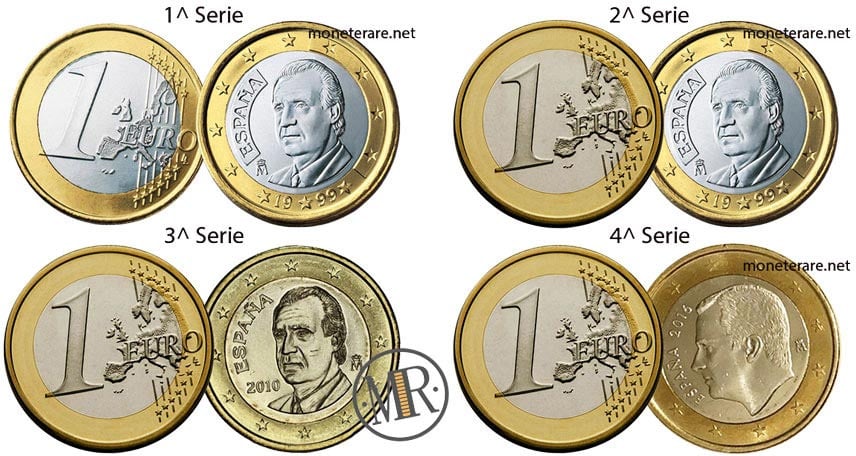
We come to the 1 Euro Spanish coin which denotes the first real difference between the old and the new edition. The author of this coin is Luis José Diaz.
As far as the 1st and 2nd editions are concerned, i.e. those between 1999 and 2009, the face of King Juan Carlos I de Borbon is depicted in the centre of the coin. To the left of the bust is the inscription ESPAÑA placed inside a section of circular crown while immediately below is the crowned M, symbol of the Mint of Madrid.
All around there are the 12 stars symbol of the European Union and the thousandth of minting placed, in groups of two digits, between the 3 stars placed at the bottom.
Instead, the 3rd edition, which was minted from 2010 to 2014, disappears the crown that closed the writing Espana and the thousandth of a coin passes to the central round of the coin on the left. The mint symbol is engraved on the right, while the representation of King Juan Carlos I remains unchanged.
As for the 4th edition (from 2015 onwards), the bust in the middle is that of King Felipe VI facing left.
To the right of the face the crowned Mint of Madrid while to the left the thousandth of minting and the inscription ESPAÑA.
All surrounded by 12 stars.
On the reverse side, the coins are identical to the other European 1 euro coins. So until 2006. the 1st edition of the coin, is with the map of the Eurozone with the borders between marked countries, borders that from 2007 onwards disappear, ie in the editions 2 ^/3 ^/4 ^
Let’s discover the technical specifications together.
Technical specifications of the Spanish 1 Euro Coin
- Materials: In this case we are talking about a double material. The outer part is nickel-brass (copper 75% – zinc 20% – nickel 5%) the inner part is copper-nickel (copper 75% – nickel 25%)
- Thickness: The thickness is equal to 2.33 mm
- Weight: Weight is equal to 7.50 g
- Diameter: The diameter is 23.25 mm
- Side dish: The contour is striped discontinuously
- Engraver: Luis José Diaz.
1 Euro Spanish Coins Value and circulation
Let’s go and see the quotations of the coins from 1 euro Spain and therefore their value for each year of minting.
1 Euro Coin Spain | First Series
1 Euro Coin Spain | Second Series
1 Euro Coin Spain | Third Series
1 Euro Coin Spain | Fourth Series
2 Euro Spanish Coins
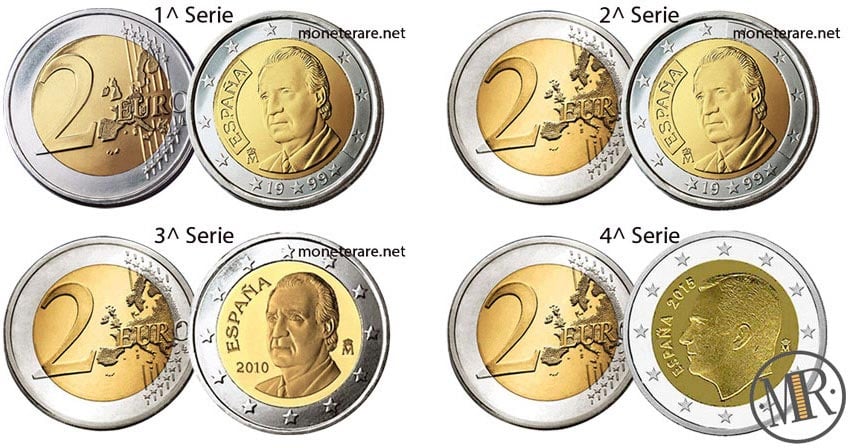
Finally, here we are with the last coin, the 2 Euro Coins of Spain. The author is the same as the one from 1 Euro or Luis José Diaz.
Again, we are talking about four different editions:
- First Edition: 1999/2006 with King Juan Carlos I and the borders between the countries of the Euro Zone
- Second Edition : 2007/ 2009 King Juan Carlos I but without borders between states that use the Euro
- Third Edition : 2010 / 2014 King Juan Carlos I new graphics and borderless map
- Fourth Edition: 2015 with King Felipe VI and map of the common face without borders between the different countries of the Euro Zone.
2 Euro Spanish Coin – First Edition
The 1st Edition has the half-bust of King Juan Carlos I onthe obverse face, facing three quarters to the left, all around the 12 stars symbol of the countries of the European Union, while the thousandth of minting is enclosed between the stars at the bottom in groups of two digits in the nickel-plated roundel.
2 Euro Spanish Coin – Second Edition
The 2nd edition (2007 – 2009) has the Straight identical to the first series and changes the Reverse that has renewed the graphics since 2007 removing the borders in the map of countries represented.
2 Euro Spanish Coin – Third Edition
The 3rd edition (2010 – 2014) differs in the Obverse from the first for the presence of the thousandth of minting directly under the writing ESPAÑA while the crowned M passes directly to the right. The reverse is always the one without borders between countries of the Euro Zone.
2 Euro Spanish Coin – Fourth Edition
Finally, the 4th edition (2015 onwards) shows the face of King Felipe VI facing left at the Straight. Always on the left there is the inscription ESPAÑA followed by the thousandth of minting. On the right instead is the crowned M. Also in this case the whole is surrounded by 12 5-pointed stars.
As far as the reverse side is concerned, the coin has the same face as the other 2 Euro European coins with the map without borders between the states.
Vediamo le peculiarità tecniche:
Technical specifications of the Spanish 2 Euro Coin
- Materials: Also in this case we speak of a double material. The outer part: copper-nickel (copper 75% – nickel 25%), the inner part: nickel-brass (copper 75% – zinc 20% – nickel 5%)
- Thickness: The thickness is 2.33 mm
- Weight: Weight increases to 8.50 g
- Diameter: The diameter is 25.75 mm
- Side dish: The contour is finely knurled with the number 2 (alternating straight and upside down) followed by two stars alternately.
- Engraver: Luis José Diaz
2 Euro Spanish Coins Value and circulation
Let’s go and see the prices of the coins from 2 euro Spain and therefore their value for each year of minting.
2 Euro Coin Spain | First Series
2 Euro Coin Spain | Second Series
2 Euro Coin Spain | Third Series
2 Euro Coin Spain | Fourth Series
2 Euro Coin 1999 Spain Value
The 2 euro Spain of 1999 does not have a particular value. In fact, these 2 euros of the first series are common coins minted in large numbers and are therefore no longer worth their face value.
2 Euro Coin 2002 Spain Value
As can be seen from the fact that they are coins minted in over 160 million copies, the 2 euro Spain 2002 have no significant value and are common.
Do you want to learn more about Euro Coins?
- Two pages you can’t miss: 2 Euro Commemorative Coins and Rare Euro Coins
- The precious Vatican euro coins can be seen here and also the San Marino euro coins
- Here you can see the Malta euro coins and here the Cyprus euro coins.
- Euro coins from Germany can be found here and Euro coins from Estonia and Latvia Euro Coins here.
- Euro coins from France can be found here, as well as Euro coins from Austria.
- Also of great interest are the euro coins from Greece and the euro coins of Luxembourg.
- Here you will find Lithuania Euro coins and Andorra Euro coins
- We also talked about Slovenian Euro coins and Slovakia Euro coins.
- Check also Spanish Euro Coins here and Euro Coins of Portugal here.
- The Netherlands euro coins can be found here and the Ireland euro coins here.
- All precious Monaco Euro coins are here and Belgium Euro coins here


